Richard Knight in “Wings of the Emerald” by Donald E. Keyhoe
THE unstoppable Donald E. Keyhoe 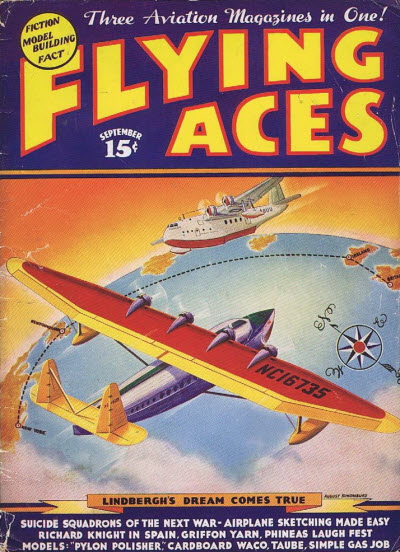 had a story in a majority of the issue of Flying Aces from his first in January 1930 until he returned to the Navy in 1942. Starting in August 1931, they were stories featuring the weird World War I stories of Philip Strange. But in November 1936, he began alternating these with sometime equally weird present day tales of espionage Ace Richard Knight—code name Agent Q. After an accident in the Great War, Knight developed the uncanny ability to see in the dark. Aided by his skirt-chasing partner Larry Doyle, Knights adventures ranged from your basic between the wars espionage to lost valley civilizations and dinosaurs. Still in Spain, Richard Knight heads back into war-torn Spain in an effort to retrieve the Green Madonna—only to find The Hawk has kidnapped Benita Navarre!
had a story in a majority of the issue of Flying Aces from his first in January 1930 until he returned to the Navy in 1942. Starting in August 1931, they were stories featuring the weird World War I stories of Philip Strange. But in November 1936, he began alternating these with sometime equally weird present day tales of espionage Ace Richard Knight—code name Agent Q. After an accident in the Great War, Knight developed the uncanny ability to see in the dark. Aided by his skirt-chasing partner Larry Doyle, Knights adventures ranged from your basic between the wars espionage to lost valley civilizations and dinosaurs. Still in Spain, Richard Knight heads back into war-torn Spain in an effort to retrieve the Green Madonna—only to find The Hawk has kidnapped Benita Navarre!
Through those blood-red skies that hung like the hand of Doom over war-wracked Spain, there swooped a winged, incarnate devil—a greedy ghoul men called “The Hawk.” Sparing neither Rebel nor Loyalist, this eerie fiend struck without warning. Wretched Iberia herself was his victim; ruthlessly he pounced upon her, and from her defenseless form his merciless talons tore priceless treasures. And now those bony claws clutched the gleaming “Green Madonna”—sought to wrench from that brilliant jewel a secret known only to Death.
Richard Knight in “Masks Over Madrid” by Donald E. Keyhoe
THE unstoppable Donald E. Keyhoe 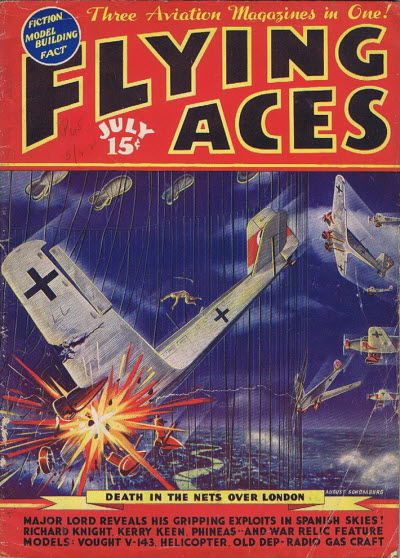 had a story in a majority of the issue of Flying Aces from his first in January 1930 until he returned to the Navy in 1942. Starting in August 1931, they were stories featuring the weird World War I stories of Philip Strange. But in November 1936, he began alternating these with sometime equally weird present day tales of espionage Ace Richard Knight—code name Agent Q. After an accident in the Great War, Knight developed the uncanny ability to see in the dark. Aided by his skirt-chasing partner Larry Doyle, Knights adventures ranged from your basic between the wars espionage to lost valley civilizations and dinosaurs. Knight is sent to Spain to get the American military men out of the Spanish Cival War, only to find the mysterious Four Faces—a criminal cabal that seek to control all crime on the earth—trying to turn La Guerra Civil into another World War with America taking all the blame!
had a story in a majority of the issue of Flying Aces from his first in January 1930 until he returned to the Navy in 1942. Starting in August 1931, they were stories featuring the weird World War I stories of Philip Strange. But in November 1936, he began alternating these with sometime equally weird present day tales of espionage Ace Richard Knight—code name Agent Q. After an accident in the Great War, Knight developed the uncanny ability to see in the dark. Aided by his skirt-chasing partner Larry Doyle, Knights adventures ranged from your basic between the wars espionage to lost valley civilizations and dinosaurs. Knight is sent to Spain to get the American military men out of the Spanish Cival War, only to find the mysterious Four Faces—a criminal cabal that seek to control all crime on the earth—trying to turn La Guerra Civil into another World War with America taking all the blame!
Above those barrage – battered buildings of Madrid, vengeful Heinkels had hemmed in a lone flyer, were pouncing in for the kill. Fascinated, Richard Knight stared up at that grim drama, saw the doomed airman cast from his lead-flailed cockpit an oddly-fashioned chest bound to the chute that would have saved him. But when Richard Knight pried the lid from that strange box, he halted, transfixed. Inside was naught but a yellowed human skull! Why had a man given his life for this?
Richard Knight in “Falcons from Nowhere” by Donald E. Keyhoe
THE unstoppable Donald E. Keyhoe 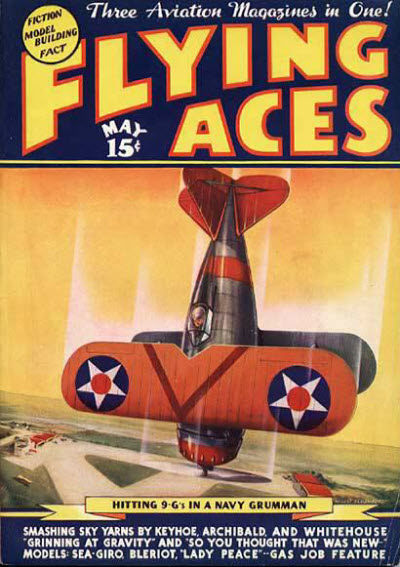 had a story in a majority of the issue of Flying Aces from his first in January 1930 until he returned to the Navy in 1942. Starting in August 1931, they were stories featuring the weird World War I stories of Philip Strange. But in November 1936, he began alternating these with sometime equally weird present day tales of espionage Ace Richard Knight—code name Agent Q. After an accident in the Great War, Knight developed the uncanny ability to see in the dark. Aided by his skirt-chasing partner Larry Doyle, Knights adventures ranged from your basic between the wars espionage to lost valley civilizations and dinosaurs. The mysterious Four Faces—a criminal cabal that seek to control all crime on the earth—has found a way to turn people to stone, which comes in handy while they continue to build their air fleet of stolen ships!
had a story in a majority of the issue of Flying Aces from his first in January 1930 until he returned to the Navy in 1942. Starting in August 1931, they were stories featuring the weird World War I stories of Philip Strange. But in November 1936, he began alternating these with sometime equally weird present day tales of espionage Ace Richard Knight—code name Agent Q. After an accident in the Great War, Knight developed the uncanny ability to see in the dark. Aided by his skirt-chasing partner Larry Doyle, Knights adventures ranged from your basic between the wars espionage to lost valley civilizations and dinosaurs. The mysterious Four Faces—a criminal cabal that seek to control all crime on the earth—has found a way to turn people to stone, which comes in handy while they continue to build their air fleet of stolen ships!
Through the growing twilight sped a powerful Northrop, and from its front pit peered Richard Knight. He saw no other ship in the sky; the secret of their mission was safe. But Richard Knight was unaware that an unseen hand was reaching through that descending pall to tear away an invisible veil—to loose upon him a hideous fate that had never before been faced by man. That fate was the ‘doom of stone’—and it had been streaming across the boundless wastes of eternity since the dawn of time.
Richard Knight in “Death Flies The Equator” by Donald E. Keyhoe
THE unstoppable Donald E. Keyhoe 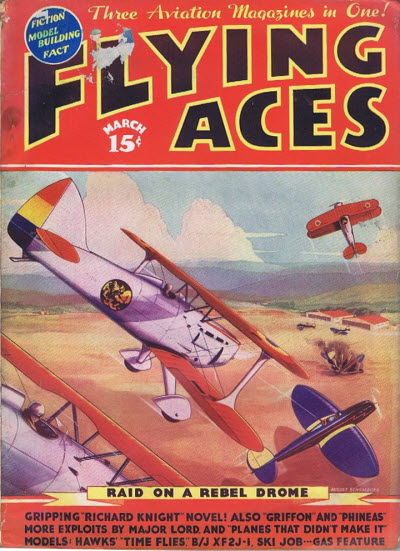 had a story in a majority of the issue of Flying Aces from his first in January 1930 until he returned to the Navy in 1942. Starting in August 1931, they were stories featuring the weird World War I stories of Philip Strange. But in November 1936, he began alternating these with sometime equally weird present day tales of espionage Ace Richard Knight—code name Agent Q. After an accident in the Great War, Knight developed the uncanny ability to see in the dark. Aided by his skirt-chasing partner Larry Doyle, Knights adventures ranged from your basic between the wars espionage to lost valley civilizations and dinosaurs. In this, his third adventure, Knight and Doyle come up against the mysterious Four Faces—a criminal cabal that seek to control all crime on the earth.
had a story in a majority of the issue of Flying Aces from his first in January 1930 until he returned to the Navy in 1942. Starting in August 1931, they were stories featuring the weird World War I stories of Philip Strange. But in November 1936, he began alternating these with sometime equally weird present day tales of espionage Ace Richard Knight—code name Agent Q. After an accident in the Great War, Knight developed the uncanny ability to see in the dark. Aided by his skirt-chasing partner Larry Doyle, Knights adventures ranged from your basic between the wars espionage to lost valley civilizations and dinosaurs. In this, his third adventure, Knight and Doyle come up against the mysterious Four Faces—a criminal cabal that seek to control all crime on the earth.
A haunted look came over the Admiral’s face. “That lost Wapiti,” he told Knight, “was found high on the beach at Crazy Day Atoll—that tiny mid-Pacific dot lying exactly at the point where East meets West, and North meets South. Underneath the island’s single palm tree sat the pilot and observer. Their bodies were stark as in death—yet they still lived! Their eyes were open—but they were eyes which only stared unseeing over the broad wastes of the sea.”
“Hell Flies High” by Donald E. Keyhoe
THE unstoppable Donald E. Keyhoe 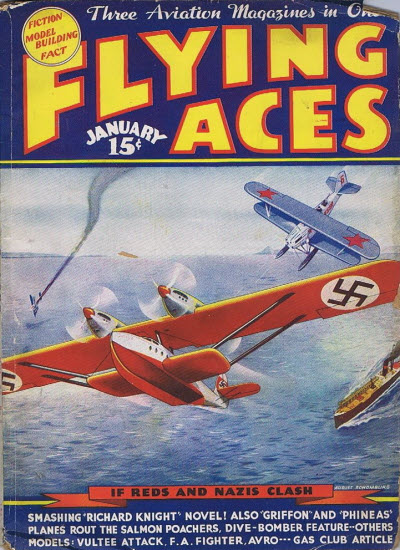 had a story in a majority of the issue of Flying Aces from his first in January 1930 until he returned to the Navy in 1942. Starting in August 1931, they were stories featuring the weird World War I stories of Philip Strange. But in November 1936, he began alternating these with sometime equally weird present day tales of espionage Ace Richard Knight—code name Agent Q. After an accident in the Great War, Knight developed the uncanny ability to see in the dark. Aided by his skirt-chasing partner Larry Doyle, Knights adventures ranged from your basic between the wars espionage to lost valley civilizations and dinosaurs. This, his second tale from January 1937, is more espionage than lost civilizations (like his first).
had a story in a majority of the issue of Flying Aces from his first in January 1930 until he returned to the Navy in 1942. Starting in August 1931, they were stories featuring the weird World War I stories of Philip Strange. But in November 1936, he began alternating these with sometime equally weird present day tales of espionage Ace Richard Knight—code name Agent Q. After an accident in the Great War, Knight developed the uncanny ability to see in the dark. Aided by his skirt-chasing partner Larry Doyle, Knights adventures ranged from your basic between the wars espionage to lost valley civilizations and dinosaurs. This, his second tale from January 1937, is more espionage than lost civilizations (like his first).
“Washington to Gray, Flight Eight . . . Washington to Gray . . . Report your position . . .†No sooner had that message rung across those leaden skies when just ahead of his speeding Northrop Richard Knight glimpsed a huge Douglas transport roaring through the snowy blur. And as he saw that ship he cringed. Gray had reported for the last time. For out of that craft’s windows there stared dilated, terrified eyes—the unseeing eyes of the dead. And the faces from which they peered were—a hideous green!
Editor’s Note: His first story, Vultures of the Lost Valley (November 1936, Flying Aces) can be found here.
“They Had What It Takes – Part 11: Richard E. Byrd†by Alden McWilliams
This week we bring you Part 11 of Alden McWilliams’ illustrated tribute to the pioneer fliers of the early days of aviation. He called it “They Had What it Takes†and this installment appeared in the December 1937 Flying Aces. It features Richard E. Byrd, the conqueror of the North and South Poles.
We won’t have a new one for you next week as we will be in Columbus, Ohio for PulpFest. If you plan to be there stop by the Age of Aces table and say hello.
Download “They Had What It Takes – Part 11: Richard E. Byrd” December 1937, Flying Aces
More Amazing Blakeslee Covers!
This week we have more great Dare-Devil Aces covers by Frederick Blakeslee. Popular Publications published some dynamite aviation art on the cover of Dare-Devil Aces! Sadly, we don’t use more than a sliver of it for our books. But that’s a design choice — We’re not trying to keep anything from you. And now we’ve added two more years of great Blakeslee covers to our growing gallery––1936 and 1937!
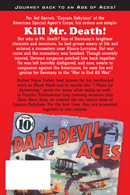 The June and December covers of 1936 are probably the two most recognizable Dare-Devil Aces covers and we have featured both of them now on back covers of our books. Our very first publication, Steve Fisher’s Captain Babyface, featured the June cover on the back. Captain Babyface and Mr Death matched wits through ten of the twelve issues that year––their last scrap appearing in the November issue. William Hartley’s The Adventures of Molloy & McNamara started running in the July 1936 issue with the adventure we choose to use as the title for the volume, Satan’s Playmates, in the December issue allowing us to utilize it’s cover in the cover design of that book.
The June and December covers of 1936 are probably the two most recognizable Dare-Devil Aces covers and we have featured both of them now on back covers of our books. Our very first publication, Steve Fisher’s Captain Babyface, featured the June cover on the back. Captain Babyface and Mr Death matched wits through ten of the twelve issues that year––their last scrap appearing in the November issue. William Hartley’s The Adventures of Molloy & McNamara started running in the July 1936 issue with the adventure we choose to use as the title for the volume, Satan’s Playmates, in the December issue allowing us to utilize it’s cover in the cover design of that book.
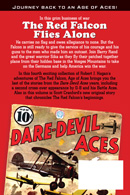 As 1936 gave way to 1937, Blakeslee’s covers move further away from depictions of planes in use during the late great hate and start to feature more contemporary planes in the frenetic melees depicted on the covers. Robert J. Hogan’s The Red Falcon was also printing it last stories in 1937 with the last Dare-Devil Aces Red Falcon story being published in the January 1938 issue. The June 1937 cover seemed to work best with the crimson cover of the Red Falcon’s fourth and final volume. This is the latest cover we’ve used, but fear not, this is not the last update to our covers gallery. There are more covers to come.
As 1936 gave way to 1937, Blakeslee’s covers move further away from depictions of planes in use during the late great hate and start to feature more contemporary planes in the frenetic melees depicted on the covers. Robert J. Hogan’s The Red Falcon was also printing it last stories in 1937 with the last Dare-Devil Aces Red Falcon story being published in the January 1938 issue. The June 1937 cover seemed to work best with the crimson cover of the Red Falcon’s fourth and final volume. This is the latest cover we’ve used, but fear not, this is not the last update to our covers gallery. There are more covers to come.
You can enjoy these as well as covers from 1932 through 1935 in our Dare-Devil Aces Cover Gallery!
“They Had What It Takes – Part 10: Major Al Williams†by Alden McWilliams
In the late thirties Flying Aces ran Alden McWilliams’ monthly illustrated tribute to the pioneer fliers of the early days of aviation which was called “They Had What it Takesâ€. In the November 1937 issue they featured the aerobatic genius, Major Al Williams.
Next week McWilliams looks at Richard E. Byrd, the conqueror of the poles.
“They Had What It Takes – Part 9: Ernst Lehmann†by Alden McWilliams
Alden McWilliams’ illustrated tribute to the pioneer fliers of the early days of aviation was called “They Had What it Takesâ€, and this week we bring you the 9th installment, which appeared in the October 1937 Flying Aces. It features the German zeppelin ace Captain Ernst Lehmann, whose last command was the ill-fated Hindenburg.
Next week, in Part 10, we will feature Major Al Williams who was considered the greatest aerobatic flier of his time.
“They Had What It Takes – Part 8: Igor Sikorsky†by Alden McWilliams
This week we bring you Part 8 of Alden McWilliams’ illustrated tribute to the pioneer fliers of the early days of aviation. He called it “They Had What it Takes†and this installment appeared in the September 1937 Flying Aces. It features aircraft developer Igor Sikorsky. Among Sikorsky’s many innovations was the first multi-motored plane.
Next week look for McWilliams’ feature on zeppelin ace Captain Ernst Lehmann, whose last command was the ill-fated Hindenburg.
“They Had What It Takes – Part 7: Amelia Earhart†by Alden McWilliams
This week we bring you the seventh installment of Alden McWilliams’ illustrated tribute to the pioneer fliers of the early days of aviation. He called it “They Had What it Takes†and this one appeared in the August 1937 Flying Aces. It features Amelia Earhart, “The First Lady of the Air”.
“They Had What It Takes – Part 6: Jimmy Doolittle†by Alden McWilliams
In the late thirties Flying Aces ran Alden McWilliams’ monthly illustrated tribute to the pioneer fliers of the early days of aviation which was called “They Had What it Takesâ€. In the July 1937 issue they featured Jimmy Doolittle who, between WWI and WWII, was considered to be America’s greatest airman.
“They Had What It Takes – Part 5: Howard Hughes” by Alden McWilliams
This week we bring you the fifth installment of Alden McWilliams’ illustrated tribute to the pioneer fliers of the early days of aviation which he called “They Had What it Takesâ€. Appearing in the June 1937 Flying Aces, it features Howard Hughes, who McWilliams called “The Scientist of Speed”. Next week we bring you Part Six, which tells the story of Jimmy Doolittle, who between WWI and WWII was generally considered to be America’s best pilot.
“They Had What It Takes – Part 4: Captain Frank Hawks” by Alden McWilliams
Alden McWilliams’ illustrated tribute to the pioneer fliers of the early days of aviation was called “They Had What it Takesâ€, and this week we bring you the fourth installment, which appeared in the May 1937 Flying Aces. It features the record smashing exploits of Captain Frank Hawks. Next week’s part five is McWilliams’ piece on Howard Hughes, who he called “The Scientist of Speed”.
“They Had What It Takes – Part 3: Sir Charles Kingsford-Smith” by Alden McWilliams
This week we bring you the third installment of Alden McWilliams’ illustrated tribute to the pioneer fliers of the early days of aviation. He called it “They Had What it Takes†and this one appeared in the April 1937 Flying Aces. It features Sir Charles Kingsford-Smith, the Australian pilot renowned for his trans-Pacific exploits. Look for part 4 next week which chronicles the record smashing speed flying of Captain Frank Hawks.
 had a story in a majority of the issue of Flying Aces from his first in January 1930 until he returned to the Navy in 1942. Starting in August 1931, they were stories featuring the weird World War I stories of Philip Strange. But in November 1936, he began alternating these with sometime equally weird present day tales of espionage Ace Richard Knight—code name Agent Q. After an accident in the Great War, Knight developed the uncanny ability to see in the dark. Aided by his skirt-chasing partner Larry Doyle, Knights adventures ranged from your basic between the wars espionage to lost valley civilizations and dinosaurs. Still in Spain, Richard Knight heads back into war-torn Spain in an effort to retrieve the Green Madonna—only to find The Hawk has kidnapped Benita Navarre!
had a story in a majority of the issue of Flying Aces from his first in January 1930 until he returned to the Navy in 1942. Starting in August 1931, they were stories featuring the weird World War I stories of Philip Strange. But in November 1936, he began alternating these with sometime equally weird present day tales of espionage Ace Richard Knight—code name Agent Q. After an accident in the Great War, Knight developed the uncanny ability to see in the dark. Aided by his skirt-chasing partner Larry Doyle, Knights adventures ranged from your basic between the wars espionage to lost valley civilizations and dinosaurs. Still in Spain, Richard Knight heads back into war-torn Spain in an effort to retrieve the Green Madonna—only to find The Hawk has kidnapped Benita Navarre!




 had a story in a majority of the issue of Flying Aces from his first in January 1930 until he returned to the Navy in 1942. Starting in August 1931, they were stories featuring the weird World War I stories of Philip Strange. But in November 1936, he began alternating these with sometime equally weird present day tales of espionage Ace Richard Knight—code name Agent Q. After an accident in the Great War, Knight developed the uncanny ability to see in the dark. Aided by his skirt-chasing partner Larry Doyle, Knights adventures ranged from your basic between the wars espionage to lost valley civilizations and dinosaurs. Knight is sent to Spain to get the American military men out of the Spanish Cival War, only to find the mysterious Four Faces—a criminal cabal that seek to control all crime on the earth—trying to turn La Guerra Civil into another World War with America taking all the blame!
had a story in a majority of the issue of Flying Aces from his first in January 1930 until he returned to the Navy in 1942. Starting in August 1931, they were stories featuring the weird World War I stories of Philip Strange. But in November 1936, he began alternating these with sometime equally weird present day tales of espionage Ace Richard Knight—code name Agent Q. After an accident in the Great War, Knight developed the uncanny ability to see in the dark. Aided by his skirt-chasing partner Larry Doyle, Knights adventures ranged from your basic between the wars espionage to lost valley civilizations and dinosaurs. Knight is sent to Spain to get the American military men out of the Spanish Cival War, only to find the mysterious Four Faces—a criminal cabal that seek to control all crime on the earth—trying to turn La Guerra Civil into another World War with America taking all the blame! had a story in a majority of the issue of Flying Aces from his first in January 1930 until he returned to the Navy in 1942. Starting in August 1931, they were stories featuring the weird World War I stories of Philip Strange. But in November 1936, he began alternating these with sometime equally weird present day tales of espionage Ace Richard Knight—code name Agent Q. After an accident in the Great War, Knight developed the uncanny ability to see in the dark. Aided by his skirt-chasing partner Larry Doyle, Knights adventures ranged from your basic between the wars espionage to lost valley civilizations and dinosaurs. The mysterious Four Faces—a criminal cabal that seek to control all crime on the earth—has found a way to turn people to stone, which comes in handy while they continue to build their air fleet of stolen ships!
had a story in a majority of the issue of Flying Aces from his first in January 1930 until he returned to the Navy in 1942. Starting in August 1931, they were stories featuring the weird World War I stories of Philip Strange. But in November 1936, he began alternating these with sometime equally weird present day tales of espionage Ace Richard Knight—code name Agent Q. After an accident in the Great War, Knight developed the uncanny ability to see in the dark. Aided by his skirt-chasing partner Larry Doyle, Knights adventures ranged from your basic between the wars espionage to lost valley civilizations and dinosaurs. The mysterious Four Faces—a criminal cabal that seek to control all crime on the earth—has found a way to turn people to stone, which comes in handy while they continue to build their air fleet of stolen ships!  had a story in a majority of the issue of Flying Aces from his first in January 1930 until he returned to the Navy in 1942. Starting in August 1931, they were stories featuring the weird World War I stories of Philip Strange. But in November 1936, he began alternating these with sometime equally weird present day tales of espionage Ace Richard Knight—code name Agent Q. After an accident in the Great War, Knight developed the uncanny ability to see in the dark. Aided by his skirt-chasing partner Larry Doyle, Knights adventures ranged from your basic between the wars espionage to lost valley civilizations and dinosaurs. In this, his third adventure, Knight and Doyle come up against the mysterious Four Faces—a criminal cabal that seek to control all crime on the earth.
had a story in a majority of the issue of Flying Aces from his first in January 1930 until he returned to the Navy in 1942. Starting in August 1931, they were stories featuring the weird World War I stories of Philip Strange. But in November 1936, he began alternating these with sometime equally weird present day tales of espionage Ace Richard Knight—code name Agent Q. After an accident in the Great War, Knight developed the uncanny ability to see in the dark. Aided by his skirt-chasing partner Larry Doyle, Knights adventures ranged from your basic between the wars espionage to lost valley civilizations and dinosaurs. In this, his third adventure, Knight and Doyle come up against the mysterious Four Faces—a criminal cabal that seek to control all crime on the earth. had a story in a majority of the issue of Flying Aces from his first in January 1930 until he returned to the Navy in 1942. Starting in August 1931, they were stories featuring the weird World War I stories of Philip Strange. But in November 1936, he began alternating these with sometime equally weird present day tales of espionage Ace Richard Knight—code name Agent Q. After an accident in the Great War, Knight developed the uncanny ability to see in the dark. Aided by his skirt-chasing partner Larry Doyle, Knights adventures ranged from your basic between the wars espionage to lost valley civilizations and dinosaurs. This, his second tale from January 1937, is more espionage than lost civilizations (like his first).
had a story in a majority of the issue of Flying Aces from his first in January 1930 until he returned to the Navy in 1942. Starting in August 1931, they were stories featuring the weird World War I stories of Philip Strange. But in November 1936, he began alternating these with sometime equally weird present day tales of espionage Ace Richard Knight—code name Agent Q. After an accident in the Great War, Knight developed the uncanny ability to see in the dark. Aided by his skirt-chasing partner Larry Doyle, Knights adventures ranged from your basic between the wars espionage to lost valley civilizations and dinosaurs. This, his second tale from January 1937, is more espionage than lost civilizations (like his first).
